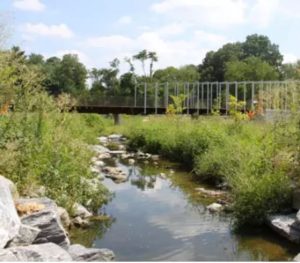Evans Parkway Neighborhood Park, a 5-acre park in the Glenview community in Montgomery County, Maryland, was long overdue for rehabilitation.
The park property was acquired by the Maryland-National Capital Park and Planning Commission (M-NCPPC) in 1954 as part of its rapidly expanding stream valley park system in the two Maryland counties to the north and east of Washington, D.C. In the 1960s, a neighborhood park was built for the community surrounding the park, but 50 years later, the aging playground and recreational facilities that were suitable for a bygone era no longer served the community’s needs.
In this community of modest single-family homes and small apartment buildings, as with many of the burgeoning Maryland communities near the Washington Beltway in the 1960s and ’70s, stormwater was primarily managed by straightening and channelizing the meandering streams that drained into the tributaries of the Anacostia River, which is itself a tributary of the Potomac River.
To manage stormwater runoff during this time of intensive development around D.C., natural floodplains were filled and steams re-routed to flow underground in concrete pipes. Those that were not buried underground were mostly redirected into open concrete-lined trapezoidal channels that were designed to rapidly move stormwater away from the developed areas, roads and homes before they became flooded.
These buried and channelized streams are perfect examples of so-called “gray” infrastructure, designed and built for many decades to treat stormwater. They may be ugly structures, but they were functional, and they served their purpose well for the past 50 years, except in the largest of storm events.
But, who wants to live with their children next to a concrete-lined stream that periodically and unpredictably fills with dangerous rushing water and leaves heaping piles of soaked and disgusting trash at culverts as the stormwater recedes?
Green Stormwater Management at the Neighborhood Scale
 With the acquisition of a 2.4-acre lot adjacent to the existing Evans Parkway Park, M-NCPPC planners saw a perfect opportunity to retrofit this park with examples of green infrastructure stormwater management techniques, including the naturalization and restoration of a 300-foot long concrete-lined stream channel.
With the acquisition of a 2.4-acre lot adjacent to the existing Evans Parkway Park, M-NCPPC planners saw a perfect opportunity to retrofit this park with examples of green infrastructure stormwater management techniques, including the naturalization and restoration of a 300-foot long concrete-lined stream channel.
Their hope was that Evans Parkway Park could serve as a demonstration site for future green infrastructure approaches to stream restoration and, thereby, engage local communities more in the health of their local watersheds. As an added incentive, they were intrigued by the idea of submitting this park renovation project for certification by the Sustainable Landscapes Initiative (SITES) program, a sustainability rating system that has sometimes been called “LEED for landscapes.”
Trish McManus, a landscape architect and design section supervisor, and Andy Frank, a civil engineer and environmental engineering section supervisor of the park development division at M-NCPPC, gave an overview of how the Montgomery County parks department has been involved with stormwater management since the 1970s.
Originally, the focus was on larger scale and regional stormwater management facilities, but with growing regard for low impact development (LID) techniques and better understanding of natural hydrologic processes, the focus moved to smaller scale systems that are more context sensitive. “We have found that by treating parts of a watershed as distinct elements of original natural systems, rather than piping stormwater to one central pipe or holding facility, it has allowed for many improvements in treating stormwater on-site, especially using groundwater recharge as a means of allowing soils and wetlands to soak up stormwater and to extend the base flows of streams,” Frank says.
This approach is now being reflected throughout the 36,000-acre park system, McManus and Frank say. They purposely leave adequate land for green stormwater management in any new park acquisitions, and they are creatively trying to look at how to retrofit gray to green facilities and parklands throughout their system.
This desire to look for opportunities to demonstrate green stormwater management techniques is what led them to choose Evans Parkway Neighborhood Park as a proposed site for a Sustainable Sites Initiative project. The department evaluated a number of parks in its system, and felt that Evans Parkway was the best choice precisely because it was a challenge.
“This community is one of our county’s older communities that were built in the period after WWII. There are extensive close curb and gutter streets, and there were concreted and channelized streams throughout these communities,” says Frank. As part of their thorough community engagement process for the park retrofit, they presented the local community with two conceptual design choices for the park’s redevelopment. They found overwhelming support for a green infrastructure approach that would lead to a more sustainable and naturalized design.
“It was a Goldilocks project for us,” says McManus. “This park involved a renovation of aging facilities and gray stormwater infrastructure and, therefore, offered multiple ways to approach the challenge of designing high-performing, sustainable landscape and recreation elements.”
McManus, Frank and others on the design team felt it was important to sell internal stakeholders as well as community residents on the value of implementing these techniques. “This project helped build a whole process of changing a mindset for both the staff and the public about parks being a part of the solution rather than just the status quo,” says Frank.
Community Engagement Important to Park Redesign
A nearby neighbor of Evans Parkway Park, Mike Smith, who is a member of the Friends of Sligo Creek and a parent of a 13-month-old child, says he has really liked the restoration of the natural stream that is a feature of the green stormwater management improvements in the park. “It is really interesting to see how the natural stream soaks up the stormwater and spreads it out. There is always more water in the natural stream than in the concrete-lined channel, and there are tree frogs calling and mallard ducks now.” He looks forward to sharing the wildlife with his child, and he says that the whole process has been educational and a great way to introduce people in the community to the benefits of stormwater control by natural methods.
Mike Fox, another nearby resident of the community, has two children ages 10 and 13 who have grown up in the park. “There used to be a concrete-lined ditch that ran through the park, and portions of the park were overgrown and full of invasive plant species,” he shares. Fox valued the broad community involvement and says there were many opinions on what kind of recreation amenities should be placed in the park and what kind of play equipment should be installed. He also says that there are many advocates for nature-based play in the community, and he, personally, would like to see more opportunities for this. He believes that the parks department should go beyond just putting a bridge over the new natural stream, which was one of the new features of the retrofit, and he would like to see a trail through the wetland and across the stream. “Let kids be kids,” he says.
Growing Importance of Green Infrastructure Stormwater Management in Parks
When asked if it was important for all park and recreation agencies to embrace the idea of green infrastructure approaches to stormwater management, McManus and Frank said without question it is important to do so. “All public agencies are under pressure to do the most they can with limited resources. Green infrastructure gives you a two-for-one benefit,” Frank explains. “You not only meet the regulatory requirements for managing stormwater, but you also gain a large public benefit.”
“Most green infrastructure projects can be designed to utilize the help of volunteers. Citizens really embrace the purpose of these projects when they see improvements that they have contributed to,” adds McManus.
McManus, Frank and other park agency planners and landscape architects endorse the idea that park and recreation agencies should get involved in implementing green infrastructure stormwater management projects in parks. “Part of it is a mindset,” says Frank. “You can take big steps or small steps. Every agency has parks and facilities that they must renovate or retrofit, and every new park project offers opportunities to integrate green stormwater management early on. In fact, the earlier you integrate it into the project the easier and less expensive it is. Waiting until later only makes it more expensive and difficult.”
“Adding green stormwater management techniques to even just 10 percent of a parking lot can give big benefits,” Frank continues. “Bioswales are easy and fast and almost foolproof. Changing mowing plans, planting more trees — try it first as a pilot, learn as you go, and keep learning.”
“We have some cool green infrastructure projects coming up,” McManus says. “We are working with a developer on one; converting an old golf course on another. Come visit!”
The total cost for the renovation and green infrastructure stormwater management retrofits at Evans Parkway Park was $3.65 million, of which $2.67 million came from Maryland’s innovative Program Open Space and $980,000 from M-NCPPC’s capital budget.
A number of park agencies that have begun to implement green infrastructure stormwater management projects in parks are discovering alternative and innovative funding sources beyond their own capital budgets, most often in partnership with water utilities that are seeking lower cost alternatives to gray infrastructure costs, according to Jessica Brooks, director of Philadelphia Water Department’s green infrastructure unit. Municipal governments may be under Consent and Decree Orders for past violations of the Clean Water Act, which mandates stormwater management upgrades, and funding may be much more available to park agencies than otherwise might be expected.
“The Evans Parkway project is a significant accomplishment for Montgomery Parks,” says Michael F. Riley, director of M-NCPPC’s Montgomery County Parks. “Every aspect of the park has been designed with the environment in mind, from the design and construction to the maintenance and operating practices to the interactive public artwork, which features images of nature that might be seen within the park. It is the first park in the county certified by the Sustainable Sites Initiative,” Riley explains about the prestigious 3-star rating from SITES. “It is a remarkable achievement for the department and for our staff who worked so hard to bring it from concept to reality.”
Photos courtesy of Montgomery Parks.
This article by Richard J. Dolesh, VP for Strategic Initiatives at the National Recreation and Park Association (NRPA) originally appeared in Parks & Recreation Magazine. Reprinted with permission.
Parks & Recreation magazine has been reporting on the development and evolution of the SITES certification for sustainable landscapes for a number of years since the original rating system was released in 2009.

